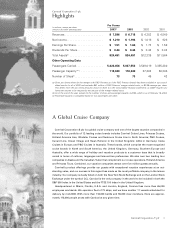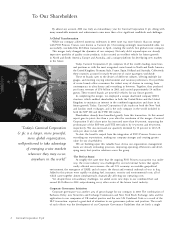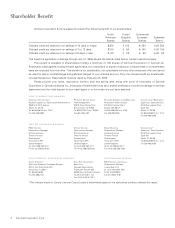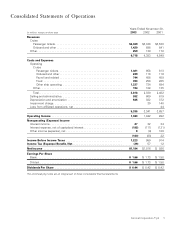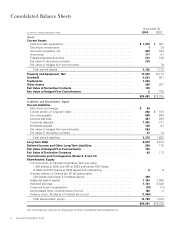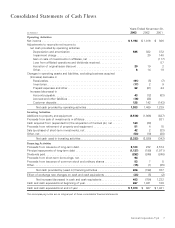Carnival Cruises 2003 Annual Report Download - page 14
Download and view the complete annual report
Please find page 14 of the 2003 Carnival Cruises annual report below. You can navigate through the pages in the report by either clicking on the pages listed below, or by using the keyword search tool below to find specific information within the annual report.11Carnival Corporation & plc
as a result of our acquisition of Carnival plc, which was
also allocated to our cruise reporting units (see Note 3).
There was no other change to our goodwill carrying
amount since November 30, 2001, other than the
changes resulting from using different foreign currency
translation rates at each balance sheet date.
The SFAS No. 142 goodwill impairment review con-
sists of a two-step process of first determining the fair
value of the reporting unit and comparing it to the car-
rying value of the net assets allocated to the reporting
unit. Fair values of our reporting units were determined
based on our estimates of comparable market price or
discounted future cash flows. If this fair value exceeds
the carrying value, which was the case for our reporting
units, no further analysis or goodwill write-down is
required. If the fair value of the reporting unit is less
than the carrying value of the net assets, the implied
fair value of the reporting unit is allocated to all the
underlying assets and liabilities, including both recog-
nized and unrecognized tangible and intangible assets,
based on their fair value. If necessary, goodwill is then
written-down to its implied fair value.
Prior to fiscal 2002, our goodwill was reviewed for
impairment pursuant to the same policy as our other
long-lived assets as discussed above (see Note 5) and
our goodwill was amortized over 40 years using the
straight-line method.
If goodwill amortization, including goodwill expensed
as part of our loss from affiliated operations, had not
been recorded for fiscal 2001 our adjusted net income
would have been $952 million and our adjusted basic
and diluted earnings per share would have been $1.63
and $1.62, respectively.
Trademarks
The cost of developing and maintaining our trade-
marks have been expensed as incurred. However, pur-
suant to SFAS No. 141, “Business Combinations,”
commencing for acquisitions made after June 2001,
we have allocated a portion of the purchase price to
the acquiree’s identified trademarks. The trademarks
that Carnival Corporation recorded as part of the DLC
transaction, which are estimated to have an indefinite
useful life and, therefore, are not amortizable, are
reviewed for impairment annually, or more frequently
when events or circumstances indicate that the trade-
mark may be impaired. Our trademarks are considered
impaired if their carrying value exceeds their fair value.
See Note 3.
Derivative Instruments and Hedging Activities
We utilize derivative and nonderivative financial
instruments, such as forward foreign currency con-
tracts, cross currency swaps and foreign currency debt
obligations to limit our exposure to fluctuations in for-
eign currency exchange rates and interest rate swaps
to manage our interest rate exposure and to achieve a
desired proportion of variable and fixed rate debt (see
Note 12).
All derivatives are recorded at fair value, and the
changes in fair value must be immediately included in
earnings if the derivatives do not qualify as effective
hedges. If a derivative is a fair value hedge, then changes
in the fair value of the derivative are offset against the
changes in the fair value of the underlying hedged firm
commitment. If a derivative is a cash flow hedge, then
changes in the fair value of the derivative are recog-
nized as a component of AOCI until the underlying
hedged item is recognized in earnings. If a derivative or
a nonderivative financial instrument is designated as a
hedge of a net investment in a foreign operation, then
changes in the fair value of the financial instrument are
recognized as a component of AOCI to immediately off-
set the change in the translated value of the net invest-
ment being hedged, until the investment is liquidated.
The ineffective portion of a hedge’s change in fair
value is immediately recognized in earnings. We for-
mally document all relationships between hedging
instruments and hedged items, as well as our risk man-
agement objectives and strategies for undertaking our
hedge transactions.
We classify the fair value of our derivative contracts
and the fair value of our offsetting hedged firm commit-
ments as either current or long-term assets and liabili-
ties depending on whether the maturity date of the
derivative contract is within or beyond one year from
our balance sheet dates, respectively. The cash flows
from derivatives treated as hedges are classified in our
statements of cash flows in the same category as the
item being hedged.
During fiscal 2003, 2002 and 2001, all net changes in
the fair value of both our fair value hedges and the off-
setting hedged firm commitments and our cash flow
hedges were immaterial, as were any ineffective por-
tions of these hedges. No fair value hedges or cash
flow hedges were derecognized or discontinued in fis-
cal 2003, 2002 or 2001, and the amount of estimated
cash flow hedges unrealized net losses which are
expected to be reclassified to earnings in the next
twelve months is not material. At November 30, 2003
and 2002, AOCI included $17 million and $8 million of
unrealized net losses, respectively, from cash flow
hedge derivatives, the majority of which were variable
to fixed interest rate swap agreements.
Finally, if any shipyard with which we have contracts
to build our ships is unable to perform, we would be
required to perform under our foreign currency forward
contracts related to these shipbuilding contracts.
Accordingly, based upon the circumstances, we may
have to discontinue the accounting for those forward
contracts as hedges, if the shipyard cannot perform.


